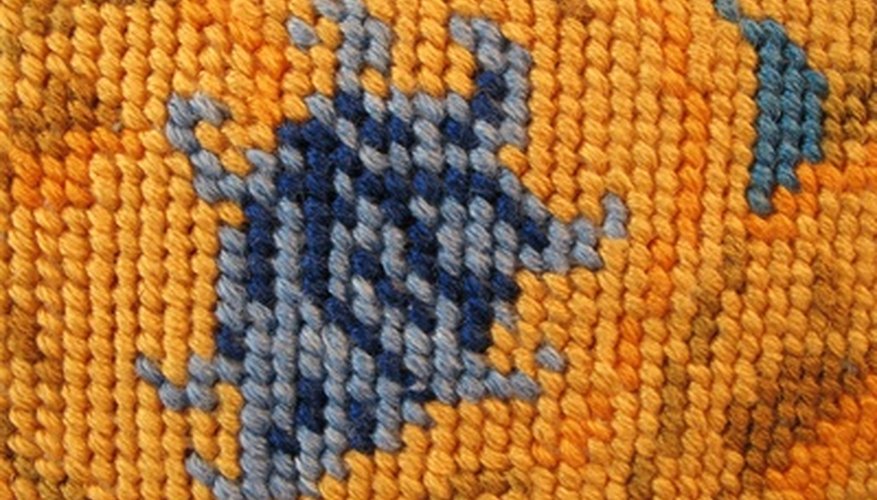Styles of needlepoint shoes run the gamut from sandals to slippers and loafers to boots. They do not have to be elaborate or fancy.
A simple design is all that it takes to make a fine pair of needlepoint slippers to keep or to give to someone who will appreciate the time, effort and skill that went into their making. With basic canvas embroidery techniques and accurate measurements, beginners as well as advanced stitchers can successfully fashion a pair of needlepoint shoes.
Make templates for the needlepoint design areas by carefully removing the tops from a pair of old shoes. If this is not possible, use the measurements of each shoe top to make the patterns. Trace the shape of the shoe top onto a piece of paper, and make separate left and right patterns. Cut out each paper template.
- Styles of needlepoint shoes run the gamut from sandals to slippers and loafers to boots.
- Make templates for the needlepoint design areas by carefully removing the tops from a pair of old shoes.
Position the needlepoint canvas so that the selvedge is on either the left or right side to provide better thread coverage and to reduce the amount of distortion when stitching. The length and width of the canvas will vary depending on the shoe size, but leave 3 inches on all sides for blocking. Mark the top of the canvas, and locate the horizontal and vertical centres. Lightly draw intersecting lines from top to bottom and side to side.
- Position the needlepoint canvas so that the selvedge is on either the left or right side to provide better thread coverage and to reduce the amount of distortion when stitching.
- The length and width of the canvas will vary depending on the shoe size, but leave 3 inches on all sides for blocking.
Place both paper shoe templates side by side on the canvas at least 3 inches apart. Properly centre the templates using the horizontal and vertical intersecting lines. Carefully trace around each template.
Remove the paper templates, and find the vertical and horizontal centres within the areas you just traced. Mark intersecting lines within these areas.
Select a needlepoint graph or chart that can be worked in continental, tent or small Bargello stitches and that fits within the design area of the shoe templates. Most public libraries have needlepoint books from which you can get lots of patterns and design ideas, or you can purchase a hand-painted canvas.
- Remove the paper templates, and find the vertical and horizontal centres within the areas you just traced.
- Select a needlepoint graph or chart that can be worked in continental, tent or small Bargello stitches and that fits within the design area of the shoe templates.
Tape all four sides of the needlepoint canvas with masking tape to prevent unravelling and to keep thread or yarn from snagging on the edges.
Slide the precut and grooved corner of one stretcher bar (the size of the canvas width) into the corner of another bar (the size of the canvas length). This will form an "L" shape. Repeat the process for the other two bars, and then put the two "L" shapes together to form a frame.
Attach the prepared canvas to the frame with brass tacks spaced 1 inch apart. Make sure the canvas is taut.
Separate the strands of Persian wool, and stitch with two strands in a tapestry needle. For single-ply tapestry yarn, stitch with the entire strand. Thread a separate needle for each colour in the design.
Work from the centre of the needlepoint chart outward until the complete design area has been covered. Maintain an even stitching tension to keep the design smooth and undistorted.
- Attach the prepared canvas to the frame with brass tacks spaced 1 inch apart.
- Maintain an even stitching tension to keep the design smooth and undistorted.
Stitch two to three additional rows in continental stitch around the design for turning and final assembly.
Restretch the needlepoint one side at a time by removing the brass tacks and pulling each side as tightly as possible, while replacing the brass tacks close together so they touch but do not overlap. Insert additional tacks as needed.
- Stitch two to three additional rows in continental stitch around the design for turning and final assembly.
- Restretch the needlepoint one side at a time by removing the brass tacks and pulling each side as tightly as possible, while replacing the brass tacks close together so they touch but do not overlap.
Spray or mist the right side of the finished needlepoint lightly with cold water to restore canvas sizing and design shape. Do not soak the needlepoint. Let stand until completely dry. If the needlepoint is still out of shape, restretch and spray again.
Remove the needlepoint from the frame, and send it to a professional finisher or shoemaker for final assembly.
TIP
Minimal blocking is needed when needlepoint is stitched on a stretcher bar frame. Ready-made slipper and shoe patterns can be found in most fabric stores. Needlepoint Bedroom slippers and scuffs can be finished by hand; but special tools are needed to finish loafers and full shoes, and therefore should be assembled by a professional.
